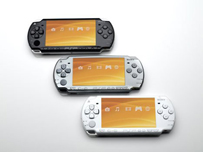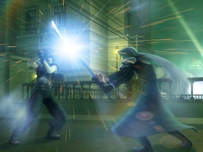
The PSP Comeback?
Date: Tuesday, November 06 @ 11:31:02 UTC
Topic: Off Topic
With Nintendo's DS hogging the handheld spotlight, it's easy to overlook how the PSP is actually becoming more viable in the marketplace.
Sony's Playstation Portable has rocked somewhat on rough water since it was unveiled at E3 2004. It had to fight automatic skepticism from its birth; the immense popularity of the Game Boy and Game Boy Advance long ago solidified Nintendo as the King of the Handheld Market. Similar hardware from Sega, Atari, Nokia and Bandai have all been crushed in the past.

However, it quickly became evident that Sony was grooming its own entry to suit several different purposes. The PSP was not just for games. It could play music, movies, share photos and even let users surf the Internet on the go. Its Swiss Army-like functions and its sleek black casing gave off a decidedly "adult" vibe next to Nintendo's Game Boy Advance and awkwardly-designed DS. When the system hit North American shelves on March 24 2005, stock sold out in many stores. Sony announced in a press conference that 500,000 units had sold in two days, netting a record $150 million.
Today, though, buses and subways are filled with kids and adults pecking away at immensely popular Nintendo DS games like Brain Age, Pokemon and Nintendogs, whereas blockbuster PSP titles are fewer and far between. Has Sony's portable dark horse buckled? There's currently a lot of pessimism in the handheld community, but there's also growing evidence that the PSP has little reason to even think about giving up the race.
Read alot more on this story
News-Source: IGN
Smaller system, persistent growth
The start of 2007 was admittedly grim for the PSP, at least next to the Nintendo DS. Its sales numbers were only comparable to the DS in January, as Nintendo had sold most of its stock during the holiday season. But after the DS re-stocked in February, the sales gap was undeniable: Nintendo moved 120,000 units by the end of the month, whereas the PSP sold approximately 42,000 units.
But the NPD's retail reports throughout the latter half of the year reveal something else: PSP sales are steadily climbing, peaking at nearly 60,000 in June. Though the increase fluctuated a little by the end of summer, September proved to be another strong month with 56,900 sales.
There's growing evidence that the PSP has little reason to even think about giving up the race.One reason for the renewed interest in the PSP is the system's redesign. Much as Nintendo saw sales skyrocket with the reinvented DS Lite, the September 2007 release of Sony's trimmer PSP-2000 (sometimes referred to as the PSP "Slim" or "Lite" by fans and the media) hasn't been ignored. Granted, it's not yet certain if the fresh attention will translate into a long-lasting positive for the system: A review by the popular tech blog Ars Technica reveals that Sony's retooling solved some problems and sparked others, whereas feedback for the Nintendo DS Lite has remained mostly positive. Regardless, the PSP-2000's lighter weight, quicker load times and its TV output still makes it an attractive purchase for anyone considering reasons to buy their first PSP.
Hardware versus software
Though hardware design goes a long way in cementing a system's fanbase, it still means little compared to the quality and variety of software available. Though the PSP initially looked fantastic next to the DS and could do everything short of cooking breakfast, consumers ultimately chose the simple fun of Nintendogs and Animal Crossing DS over having access to a portable movie theater.
Sony still plans to market the PSP's multiple functions in the future. "Because the PSP is a multi-functional device with a diverse and expanding feature set, the system's marketing will always emphasize its versatility," explains John Koller, senior marketing manager for the PSP. "For example, our recent research shows a substantial growth in those who use the PSP for listening to music."
Koller also notes a large number of users still make extensive use of the system's ability to download videos and play UMD-format movies, which, due to decreasing support from studios and retailers, are now available for "the right price."
Despite Sony's enthusiasm over the PSP's versatility, its primary function will always remain as a gaming system. "Gaming will always be at the heart of the PSP. With a majority of PSP owners using the system primarily for gaming, it's not a stretch to see our marketing emphasize the top titles available."
Strong third-party support

After a bit of an awkward start, developers found their feet with the Nintendo DS and now let their imaginations run wild on the system's trademark touch screen. For example, Hotel Dusk: Room 215 is an "interactive novel" by Cing wherein the player uses the stylus to control the protagonist, Kyle Hyde, as he sorts through a tangled mystery involving a run-down hotel. The touch controls allow him to rummage through items and investigate clues. Inspired by new ideas and high sales numbers, third party developers are devoting time and effort to the DS.
Sony has always commanded strong third-party support for its systems since the success of the original PlayStation, and Koller believes that PSP developers are similarly finding ways to get creative and present fun titles. "Upcoming launches such as God of War: Chains of Olympus from a first-party perspective, and Star Wars Battlefront: Renegade Squadron from LucasArts, are certainly good examples of fantastic franchises made unique on the PSP," he says. "It's clear that consumers do not want the same game on their PSP that they play on console."
"It's clear that consumers do not want the same game on their PSP that they play on console."There's also something to be said for the right developer having the right kind of influence. In the week ending September 26th 2007, Sony sold a remarkable 95,487 PSPs in Japan. The release of Crisis Core: Final Fantasy VII by Square Enix drove hardware sales through the roof.
Sony also has, and will continue to have, strong Japanese and American support from other major developers such as Capcom. "With more than 1 million units of Monster Hunter Portable and now more than 1.4 million units of Monster Hunter Portable 2nd (and counting), nothing has moved PSP hardware in that market like Capcom," says Christian Svensson, senior director of strategic planning and research for Capcom. "For the first half of 2007, according to Media Create, Monster Hunter Portable 2nd on PSP was the single best selling piece of software in Japan across all platforms."
The company, which produces bestselling franchises such as Street Fighter, Resident Evil and Mega Man, is confident about the PSP's future, especially in the US. "I think that by and large US publishers are happy with the amount of hardware thatís selling," says Svensson. "Thereís certainly enough of them out there to be a viable marketplace."
Good things for the industry
Game developer Atlus has produced a number of titles for the DS, the most popular of which is Trauma Center: Under the Knife. The game incorporates the stylus as a scalpel, calling on players to perform "surgeries" on ailing patients.
Despite Atlus' seeming emphasis on DS development, its assistant manager of public relations, Aram Jabarri, recognizes the PSP's potential and recent growth. It can, he speculates, only be a positive thing. "The industry is fortunate to have two handheld platforms to develop and publish for that are not only both viable, but seem to both also have their own audiences. In addition, both systems have had hardware revisions, taking into account consumer input and improving a few initial design choices to create a superior product."
This, Jabarri believes, means stronger and better software as well as developers who will continue to support the PSP in the future. What's more, the release of the PSP-2000 may help things along. "Hardware revisions tend to reignite interest, and therefore even older titles that may have been overlooked at one point will possibly get another round of consideration," Jabarri speculates. "This was evidenced by our title Trauma Center: Under the Knife. Released in 2005, it really was not until the release of the DS Lite that sales of the game dramatically improved."
Christmas is coming
Will the PSP's momentum last into Christmas, or will it be a second or third choice for shop-weary parents? Will its multiple functions continue to intimidate members of Nintendo's "Touch Generations," such as the very casual gamer who just wants to go a round on Brain Age? Koller's answer is a little surprising. "According to recent research, the PSP has been the most widely accepted portable system across a diverse range of age groups. Although the core demographic is still the teen male, we've seen a lot of growth in the under 12 and over 35 market which is extremely exciting."
As for Christmas 2007 and Beyond? "We feel very strongly that the PSP's momentum will continue through the holiday season and well into the future."
The PSP is still very much in the minds and hearts of Sony, fans and developers. It won't be long before we see what kind of demand Santa ends up shouldering.
News-Source: IGN
|
|